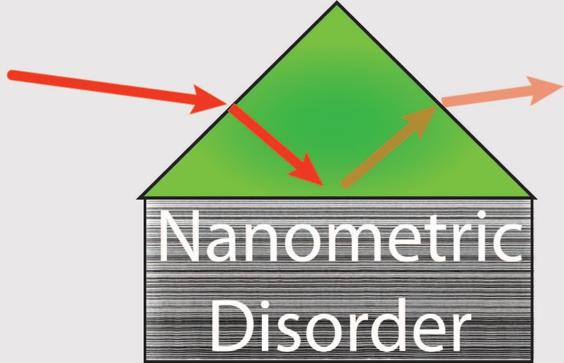1-JUN-2017
We cannot see atoms with the naked eye because they are so small relative to the wavelength of light. This is an instance of a general rule in optics - light is insensitive to features which are much smaller than the optical wavelength. However, a new experiment appearing in Science shows that features that are even 100 times smaller than the wavelength can still be sensed by light.
Hanan Sheinfux and Dr. Yaakov Lumer, from the group of Prof. Moti Segev at the Technion -Technical Institute of Israel, carried out this study in collaboration with Dr. Guy Ankonina and Prof. Guy Bartal (Technion) and Prof. Azriel Genack (City University of New York).
Their work examines a stack of nanometrically thin layers - each layer is on average 20,000 times thinner than a sheet of paper. The exact thickness of the layers is purposely random, and ordinarily this nanometric disorder should bear no physical importance. But this experiment shows that even a 2nm (~6 atoms) thickness increase to one single layer somewhere inside the structure can be sensed if light illuminates the structure at a very specific angle of incidence. Furthermore, the combined effect of all the random variations in all of the layers manifests an important physical phenomenon called Anderson localization, but in a regime where it was believed to have vanishingly small effects.
"This work demonstrates that light can be trapped in structures much thinner than the wavelength of light and that minute changes in this structure are observable," said Dr. Genack. "This makes the structure highly sensitive to the environment."
The discovery of electron localization in 1958, for which Anderson was awarded the Nobel Prize in 1977, is the phenomenon where disorder turns a system from a conductor to an insulator. The phenomenon has been shown to be a general wave phenomenon and to apply to light and sound as well as to electrons. Anderson localization is a notoriously difficult effect to demonstrate in the lab. Generally, localization has practically no effect when random features of a sample are much smaller than the wavelength. Indeed, the random arrangement of the atoms in a disordered medium such as glass is not observable with visible light: the glass looks completely homogeneous, even under the best optical microscope. However, the localization effect seen in this recent experiment is surprisingly potent.
As a crude analogue to the physics enabling these results, try speaking to a friend in the same room with a loud engine. One way to be heard is to raise your voice above the sound of the engine. But it might also be possible to speak if you can find a quiet spot in the noise, where the engine's sound is relatively weak. The engine's sound is analogue to the "average" influence of the layers and raising your voice is the same as using "strong" disorder with wavelength-sized components. However, this experiment has demonstrated such structures exhibit an "exceptional point" which is equivalent to the quiet spot in the room. It is a point where, even if the disorder is weak (nanometric), the average effect of the structure is even weaker. The parts of the experiment performed in the vicinity of this point therefore show an enhanced sensitivity to disorder and exhibit Anderson localization.
These findings are a proof-of-concept which may pave the way for major new applications in sensing. This approach may allow the use of optical methods to make high-speed measurements of nanometric defects in computer chips and photonic devices.
###
The City University of New York is the nation's leading urban public university. Founded in New York City in 1847, the University comprises 24 institutions: 11 senior colleges, seven community colleges, and additional professional schools. The University serves nearly 275,000 degree-credit students and 218,083 adult, continuing and professional education students.
For more information, visit http://www.cuny.edu/research?















